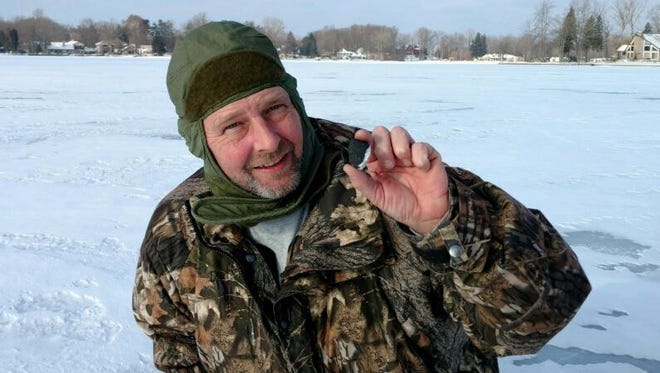Meteorite hunters find 6 fragments of Michigan meteor
It was only a small mound amid bright white snow, but the microscopic black speck sitting atop the frozen lake near Hamburg, Michigan, early Thursday took on profound proportions for Larry Atkins.

The Michigan native had left his winter home in Arizona less than 48 hours earlier to, like other enthusiasts, scour the land to snag a prized piece: the fallen evidence of a meteor that crossed over the region Tuesday night, astonishing viewers in several states and Canada.
With two other “hunters” active with the American Meteor Society, Atkins had used Doppler radar to pinpoint the “strewn field,” or path littered by the meteorites that had plummeted to earth. And within 15 minutes, one of his companions spotted the first space rock.
“We knew we were in the right spot,” Atkins said. “In 15 minutes or less I found No. 2. After that, I found the third maybe an hour or so later.”
The trio ended up netting six fragments — which American Meteor Society officials believe are the first of the much-sought-after meteorites to be found in the region.

“These guys found them two days later — it’s incredible,” said Mike Hankey, operations manager for the American Meteor Society.
Those remnants must undergo analysis at a laboratory accredited to certify meteorites, such as Chicago’s Field Museum. Still, all three discoverers with decades of exploration experience between them have sky-high hopes.
“To be able to witness and observe an event happening in the sky that a great number of people notice and then use information to go retrieve a piece of that an extraordinary thing,” said Darryl Landry of Waterford Township, who was on the team.
Thursday ended up being an auspicious date for recovering the coveted masses. Officials with Longway Planetarium in Flint believe their team and a stargazing group retrieved three others later that day, south of Howell. One is set to undergo NASA analysis, executive director Todd Slisher said.
“These are not easy to find,” he told reporters during a press conference Friday. “We’re really happy and extremely excited that we were able to find this.”
Trackers had started combing southeast Michigan for the relics the day after a NASA camera spotted the meteor in Ohio.
AMS estimates it traveled some 28,000 miles an hour, penetrated deep into the atmosphere then shattered — producing a fireball and loud “booms” at least 77 observers heard. At one point, the U.S. Geological Survey recorded a 2.0 magnitude burst.
Spotting a meteoroid over Michigan is rare, NASA officials say. The chance to find meteorites in the state lured Atkins and Robert Ward, another hunter, from Arizona to join Landry in the search Thursday.
They relied on radar data showing the specimens might have dropped onto a nearly 20-mile-long swath in and around Livingston County. Within hours, braving frigid temperatures and ice-covered surroundings, the team split up and quickly collected six meteorites.

“It was a very good day,” said Ward, a “space cowboy” from Prescott, Arizona, who has collected about 600 meteorites worldwide over the years and gathered three Thursday. “It was an absolutely textbook event.”
The group sought material with the tell-tale signs it originated elsewhere: charcoal-black exterior, no holes, dense and heavier than expected. The frosty conditions allowed them to scrutinize a bit more closely.
“We’re very lucky they didn’t sink,” Landry said. “It’s a rare opportunity to actually be able to walk out on the lakes and see what’s there and pick them up. Otherwise we’d have no chance for it.”
The Longway group encountered their three finds — including one roughly the size of a nickel — near ice, Slisher said, adding members identified the black “fusion crust” that typically covers such projectiles. “We’re pretty sure the meteor that came down that shattered and fragmented was stony and this was one of the pieces.”
The planetarium hopes to permanently display the rocks, Slisher told reporters Friday. “It’s pretty jaw dropping to think about this."
Others hoping to repeat their success might need patience, but chances are plenty more rocks fell, Hankey said. “Realistically, there are thousands of meteorites scattered about. ... This hunt will last for months.”
The quest has prompted the Cranbrook Institute of Science in Bloomfield Hills to plan a meteorite inspection and learning event from 1-4 p.m. Saturday.
Meanwhile, Darryl Pitt, a curator at Macovich Collection of Meteorites in New York and meteorite consultant to the Christie’s auction house, is offering $20,000 to the first person willing to sell a recovered chunk weighing at least 2.2 pounds (1 kilogram).
“I want to motivate more people to look,” Pitt, a Michigan native, said Thursday night. “If you take every meteorite known to exist, take the total weight, they still weigh less than the world’s annual output of gold. Meteorites are extraordinarily rare and the world is just coming to terms with how special they are.”
Those trekking out to net the nuggets should beware, though.
Federal law says meteorites belong to the owners of the property where they land. Testing must determine whether the find qualifies as one, and even if that’s the case, “no meteorite is worth millions of dollars,” said Bill Cooke, who leads NASA’s meteoroid environment office in Alabama. “Meteorites, like gold, are prized according to type and weight.”
Figures can vary depending on circumstances, including the market and collectors’ interest, but prices for the first found and certified pieces could start at $100 per gram, Hankey said. However, he added, “if more are found, the price will go down.”
Even so, scientists seek the rocks to learn more about the phenomenon, Hankey said. “It’s got a huge scientific, historic, human value. The monetary value is secondary.”
That’s why Atkins and his team plan to keep searching for more artifacts.
“These rocks are virgin materials from the building blocks of our solar system,” he said. “When you’re holding a meteorite, you’re holding something. It’s not just a rock.”